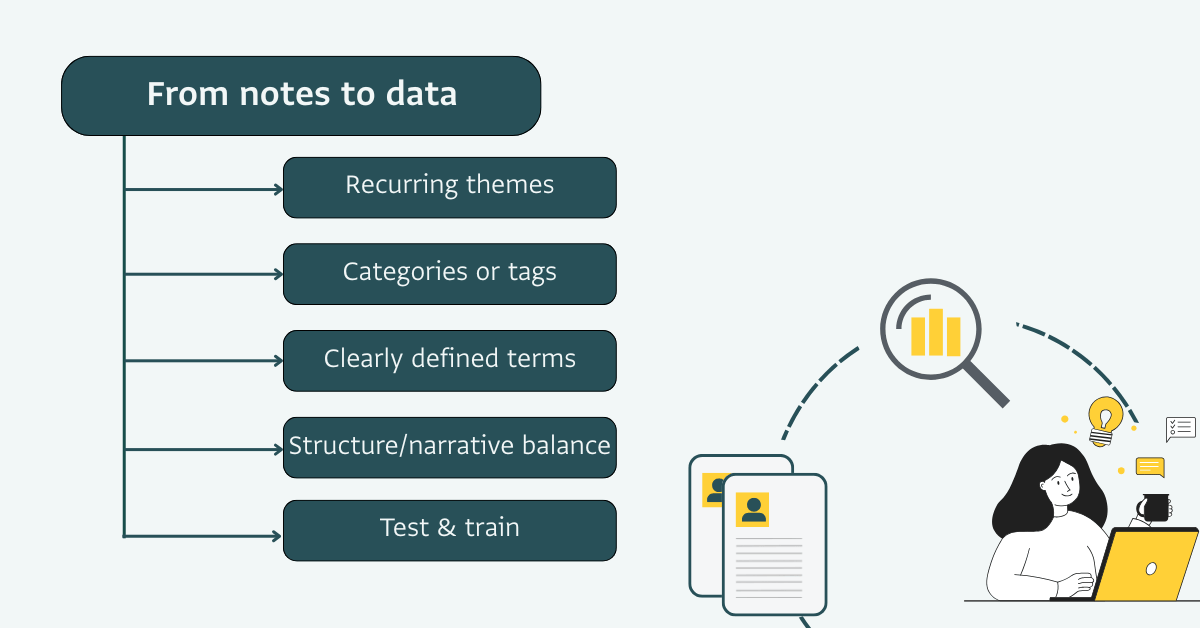From notes to numbers - How to turn casework into usable data for case management
In case management systems, every intake, home visit, or follow-up is full of rich detail. But when it comes to monitoring progress, reporting, or scaling programs, stories need structure so that they can be turned into usable data that will help drive decision-making.

Stories, often written in the form of notes, are detailed, narrative-style observations and can include what a client said, how a visit went, what challenges came up, etc.
Data on the other hand is structured, repeatable, and easier to analyze across many cases such as yes/no fields, dates, dropdown choices, or numeric scales.
When you extract key details from notes and capture them in a structured way, you can spot patterns (e.g. how many clients need psychosocial support?), improve services and report outcomes. When done well, structured data complements your notes giving you a full picture of each case and your caseload.
How to turn casework into usable data
Here are five practical ways to start:
1. Identify recurring themes in your notes
Look back over a few weeks of case notes. What words or ideas keep appearing? These are good candidates to track with structured fields. These might be already mentioned in the official case management guidelines your organization follows but you might discover other useful information that could support your operational work, if captured. Examples:
- Support type (legal, shelter, livelihoods)
- Referral outcomes (completed, pending, declined)
- Risk level (low, medium, high)
2. Create simple categories or tags
Instead of writing “client was very anxious and withdrawn,” use a dropdown to tag this under “psychosocial concern.” Keep categories clear and mutually exclusive wherever possible and use additional text fields for notes with clarifications if that is needed.
3. Define your terms
Be sure everyone on the team agrees on what a field means. If you track “household visit,” does that include group visits? Phone calls? Defining terms prevents confusion later. Document the terminology and share with everyone involved.
4. Balance structure and narrative
Use structured fields for what you need to analyze or report. Keep narrative fields (like "caseworker comments") for context or nuance. In this case, you don’t need to turn everything into checkboxes.
5. Train and test with real cases
Test your forms using real examples. Ask caseworkers: “Can you record what you usually write here in this structured format?” Adjust your form based on feedback and test again.The more user-friendly the system you create, the easier it will be for your teams to adopt it.
Example: turning a case note into data
Take a look at the following example of turning a note into structured data fields.
Original note: “Met with a client and her child at the safe house. The child hasn’t attended school in 2 months. Mother wants education support and mentioned previous experience of abuse by partner. Referred to the psychosocial team.”
Structured data fields:
- Visit type: Home visit
- Client type: Adult + child
- Education gap identified: Yes
- Requested service: Education support
- Risk history: Intimate partner violence
- Referral made: Yes
- Type of referral: Psychosocial support
Once you structure your information into data fields it becomes much easier to design forms that will help your team track the case’s details and progress.
Did you know that you can use ActivityInfo for operationalizing your case management system? If you need support designing your case management system in ActivityInfo never hesitate to contact us to discuss the needs of your program.